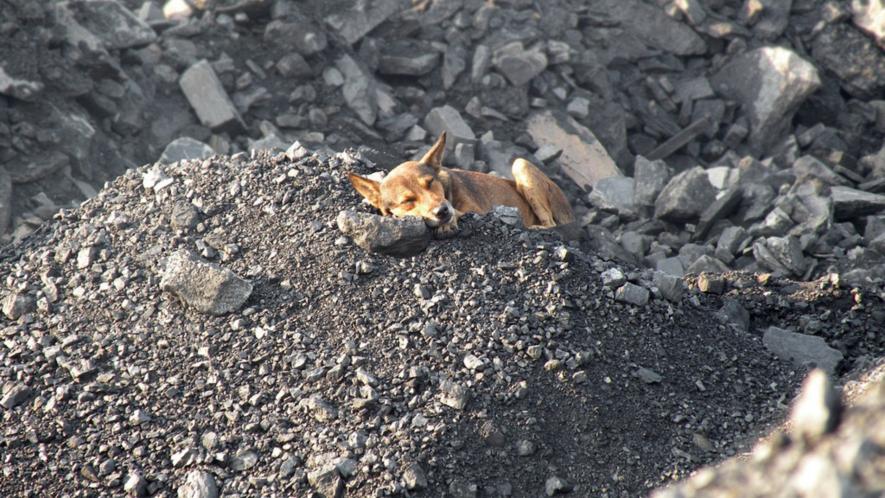Coal Stumbling Block in Sourcing 50% Power From Renewables by 2030

Image Courtesy: Flickr
New Delhi: The Narendra Modi government has set an ambitious target of meeting 50% of the country’s energy requirements from renewable sources by 2030.
However, government data indicates an overwhelming dependence on coal while renewable energy generation has been low despite adequate capacity installation in the sector. Given the country’s growing per capita energy consumption, experts argue coal cannot be wished away.
Renewable energy sources account for 41.4% of the total installed electricity generation capacity. However, the sector contributed a mere 10.55% to the total electricity generated in the 2022-23 financial year. Coal-based plants were the primary supplier of electricity providing an overwhelming 87.07% of the total power generated.
The Centre’s confidence in achieving net-zero emissions by 2070 and halving its dependence on fossil fuels by 2030 has been reiterated by Union ministers occasionally.
At a recent conclave in New Delhi, Union minister of science and technology Jitendra Singh said that the country is set to achieve its target of generating 500 gigawatts (GW) of non-fossil fuel energy by 2030 thereby fulfilling, at least, half of its energy requirements. Singh also expressed satisfaction that India is on its way to achieving net-zero emissions (complete independence from coal-based electricity) by 2070.
Despite these claims, the government’s initiatives in the coal sector, however, have been criticised by advocates of clean air mechanisms.
“For meeting the non-fossil fuel-based energy target, the government should stick to its objective of increasing capacity of renewable energy sources and phasing out coal plants,” said Sunil Dahiya, an analyst at the independent research organisation Centre for Research on Energy and Clean Air (CREA).
According to Dahiya, “no coal power plants were approved in 2022”. “In 2023, there has been an uptick in capacity enhancement of coal-based projects. This line of action is divergent from the government’s policies and will lead the nation away from achieving the objective of achieving net zero emissions by 2070.”
A CREA analysis done in association with the San Francisco-based NGO Global Energy Monitor has revealed that three non-captive coal plant expansion projects with a total capacity of 3.9 GW received approval in the first five months of 2023.
The analysis further revealed that nearly 11.5 GW of coal-power capacity, under development, was approved in various stages during this period. Further, the government has provided 7.6 GW of coal projects with terms of reference to carry out environment impact assessment studies ahead of clearing the decks for construction work.
“For India to achieve its clean energy ambitions, it is crucial to put the brakes on new coal plant announcements and approvals and reassess every new coal plant under consideration,” the report states.
“Any prioritisation of coal power to address short-term challenges or satisfy other interests threatens an efficient energy transition. Pursuing new coal projects diverts financial support and judicious planning from renewable energy projects, resulting in a lock-in of resources that could otherwise be invested in a true coal-to-clean strategy,” the report further states.
The government’s continued emphasis on coal-based energy projects is corroborated by the National Electricity Plan (NEP), released in May. The NEP data shows that fossil-fuelled power plants accounted for 99.65% of capacity addition to conventional energy sources in 2017-22.
During this period, the total capacity added to conventional energy sources was 30,667.91 megawatts (MW), including 30,562 MW of coal-based energy sources alone—though 54,779.15 MW were added to renewable energy sources (including hydro-power).
Experts support the government’s claims that capacity instalment in the renewable energy sector will breach 50% by 2030. There is no disagreement to claims that the share of non-fossil fuel-based capacity is expected to increase to 57.4% by the end of 2026-27 and to 68.4% by the end of 2031-32. However, with the coal mining sector also steadily flourishing, the government’s commitment to the furtherance of clean energy and zero-carbon footprints is doubtable.
Since June 2020, when Prime Minister Modi opened the coal sector to commercial mining by private players, at least, 91 new blocks have been auctioned. Five of these mines have also begun operations.
Due to social and environmental governance issues, banks and financial institutions are reluctant to grant loans to successful bidders for operationalising the mines. To overcome this roadblock, the government is already considering to classify coal mining projects under “infrastructure sector”. This would enable banks and financial institutions to formulate policies to meet the needs of investors.
Data also indicate that coal production has steadily grown in the last 10 years—barring 2020-21, when the pandemic put brakes on economic activities—and touched a record level of 893.19 million tonnes (MT) in 2022-23.
As per the coal statistics report released by the government on October 17, around 1.163 MT of the coal produced in 2022-23 was exported to Nepal, Bangladesh and Bhutan. The rest was used in domestic power plants. In addition, domestic power plants also imported 237.668 Mt of coal for blending. Coal imports have increased by 13.92% in 2022-23 compared to 2021-22.
As per the coal ministry, the daily coal supply is more than consumed in thermal power plants. In 2022-23, coal production grew by 14.77% compared to the previous fiscal.
Latest estimates indicate that between April and October, coal production grew at the rate of 12.73% compared to the same period in the previous fiscal. Total electricity generation in 2022-23 increased by 8.8% compared to the previous financial year—but most came from coal.
The growth percentage of renewable energy generation in this period was a mere 0.22%. At 10.55%, the share of renewable energy in total electricity generation is much lower than the world average.
As per a report released by the International Renewable Energy Agency, an inter-governmental organisation facilitating and promoting the sustainable use of renewable energy, in July, the share of renewables in electricity generation globally in 2021 was 27.8%, a 0.2% increase over the 27.6% recorded in 2020.
The NEP does not seem to be in sync with the government’s target in achieving 50% net-zero emissions by 2030. The plan estimates that the contribution of renewable energy sources will be 35.04% of the total energy demand by 2026-27 and will reach only 43.96% by 2031-32. It indicates that India is unlikely to reach the halfway mark.
Experts feel the consumption of coal-based energy will not decline, at least, for the next 25 years. This has been attributed to the country’s unique position due to the low per capita electricity consumption, which will take many years to match the consumption levels in developed countries like the US, the UK and China.
“In developed nations, energy consumption has reached a saturation level. So, any addition of renewable energy capacity will result in phasing out of an equivalent capacity of coal-based projects,” former Coal India Limited chairperson Partha Sarathi Bhattacharya said.
“For India to reach a saturation level of energy consumption matching the consumption levels in developed nations, there needs to be a huge addition of incremental capacity. This incremental capacity cannot be met through renewables alone,” he added.
As per government data, per capita electricity consumption was 1,255 units (where 1 unit = 1 kilowatt hour) in 2021-22, around one-third of the global average. It has been further argued that meeting the energy requirements of the entire population is more important than climate change concerns despite international headwinds towards the advancement of clean energy and the rejection of coal as a dirty fuel.
“To beat these international headwinds, the least that can be done in the coal mining sector is to ensure that mining, transportation and usage of coal are carried out in the most benign and sustainable manner possible,” Bhattacharya said.
“Focus should be on underground mining instead of opencast methods with greater stress on mechanised methods. Surface miners by which drilling and blasting can be avoided should be prioritised. All coal should be processed, including setting up washeries at pitheads to avoid muck transportation over long distances,” he added.
The writer is a freelance journalist.
Get the latest reports & analysis with people's perspective on Protests, movements & deep analytical videos, discussions of the current affairs in your Telegram app. Subscribe to NewsClick's Telegram channel & get Real-Time updates on stories, as they get published on our website.






















